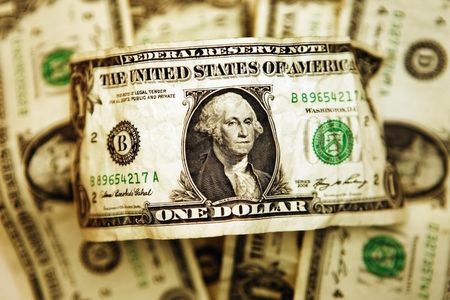
Investing.com – The U.S. dollar slipped slightly Friday, falling from a six-week high ahead of a key jobs report that could determine sentiment ahead of the Federal Reserve’s next meeting.
At 04:25 ET (08:25 GMT), the Dollar Index, which tracks the greenback against a basket of six other currencies, traded 0.1% lower to 101.667, just off the previous session’s six-week high.
The index is up nearly 1.5%, for the week, its strongest such performance since April.
Payrolls to guide dollar movements
The dollar has been boosted this week by reasonably healthy labor data – job openings, ADP private payrolls and weekly jobless claims – as well as safe-haven demand given the widening Middle East tensions and the potential impact on the global economy.
Attention now turns to the publication of the September nonfarm payrolls report, which is likely to guide market expectations of further interest rate cuts by the Federal Reserve.
The US economy is tipped to have maintained a moderate pace of job growth during the final month of the third quarter, with payrolls rising 147,000, while the unemployment rate is seen matching August’s level of 4.2%.
ING is a little more pessimistic than consensus, expecting 115,000 for payrolls and 4.3% for the unemployment rate.
“That probably doesn’t change the picture for the Federal Reserve, which should still cut by 25bp in November and push back against 50bp for the time being,” ING analysts said, in a note. “However, some hawkish repricing in the USD OIS curve has already happened this week, and the dollar could correct lower on a slightly soft jobs report.”
Euro weakens with the ECB seen cutting further
In Europe, EUR/USD drifted lower to 1.1027, with the euro having dropped over 1% this week on further signs of cooling inflation in the eurozone overshadowing strengthening activity data and French industrial production growth.
The European Central Bank has already started cutting interest rates, and the normally hawkish policymaker Isabel Schnabel took a more dovish stance earlier in the week, increasing the expectations of another interest rate cut later this month.
“We retain a moderate bearish bias on EUR/USD in the near term, even if our baseline expectation for a tick higher in US unemployment should offer a respite today,” ING added.
“Ultimately, the less supportive rate differentials, risk sentiment instability and a turbulent EU budget season mean EUR/USD could stay under pressure. 1.1000 is a big support, so a break lower could mean the correction extends to 1.09 relatively quickly.”
GBP/USD rose 0.2% to 1.3154, rebounding slightly after sliding 1% on Thursday after Bank of England Governor Andrew Bailey said the central bank could aggressively cut rates if inflation pressures continued to ease.
Sterling had been on a bull run, and is still up over 3% this year, largely on expectations that the BoE will keep interest rates higher for longer than the Federal Reserve as inflation remains sticky.
Policy uncertainty hits yen
USD/JPY fell 0.4% to 146.28, having risen to an over six-week low of 147.25 a day earlier, amid uncertainty over future Bank of Japan monetary policy.
Despite today’s gains, the yen is still on track to log a decline of almost 3% this week after comments from new prime minister, Shigeru Ishiba, stoked expectations that rate hikes in Japan are further away.
USD/CNY was largely unchanged at 7.0185, with Chinese markets now closed until Tuesday as the country celebrates Golden Week.
This post is originally published on INVESTING.


